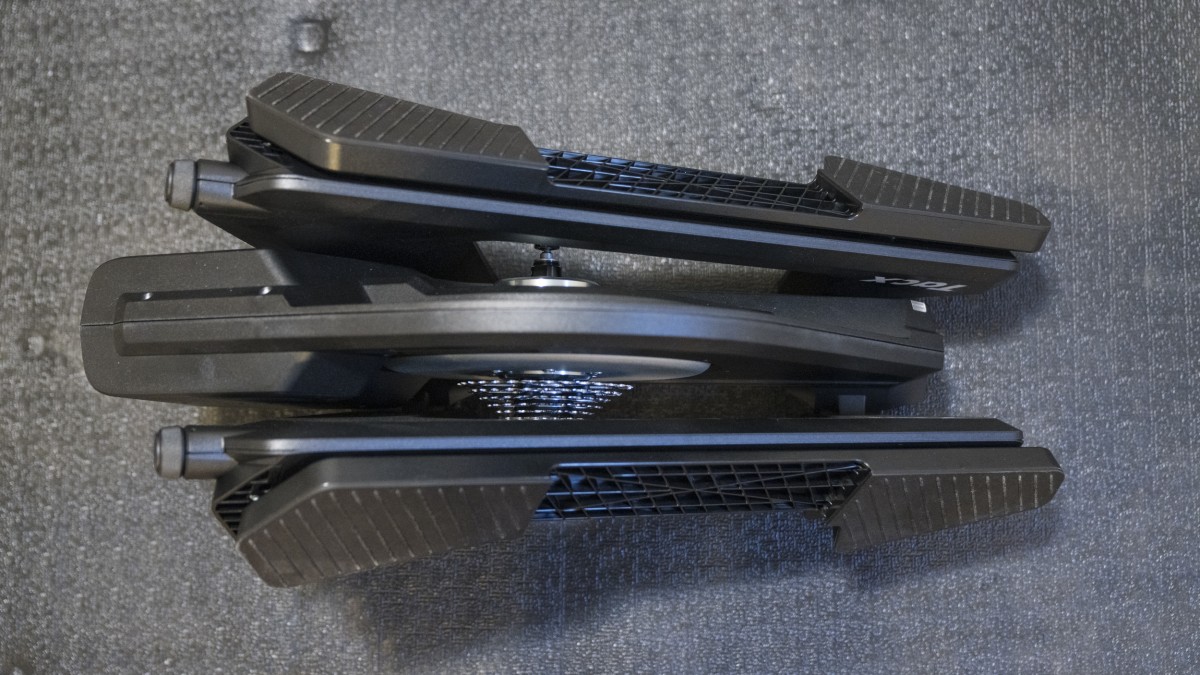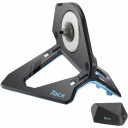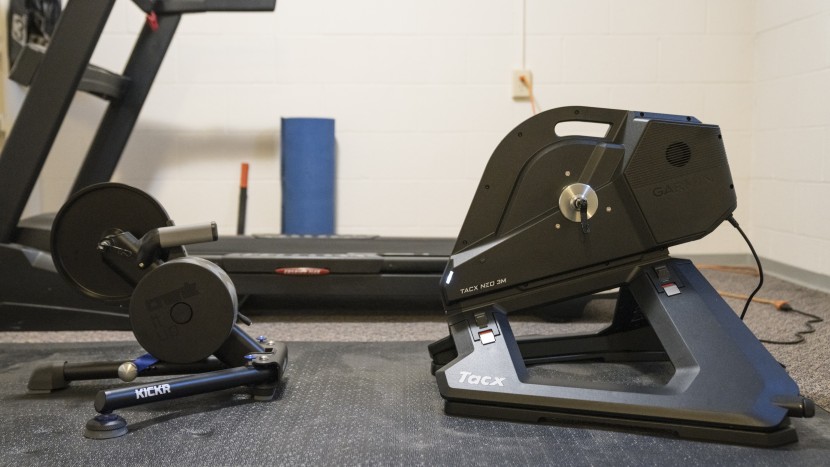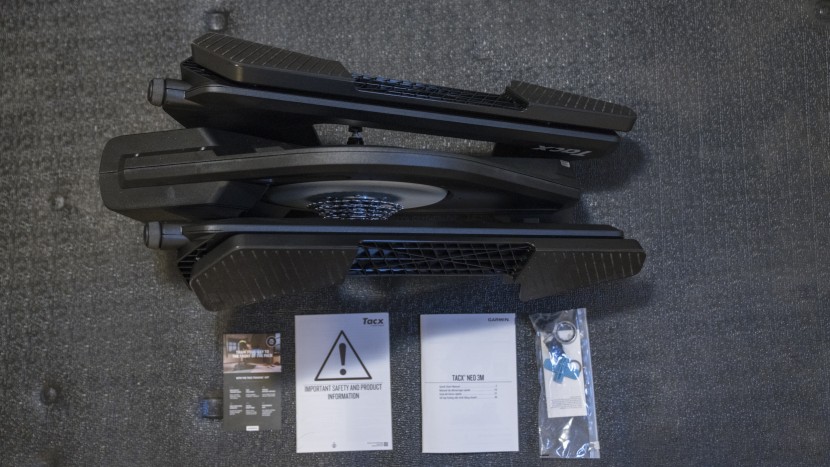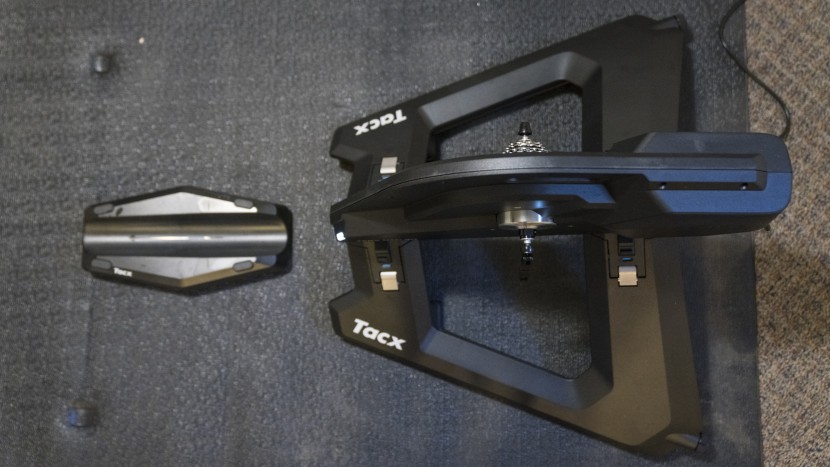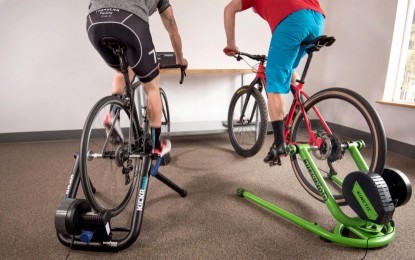Our Verdict
Compare to Similar Products
 This Product
Garmin Tacx Neo 3M | |||||
|---|---|---|---|---|---|
| Awards | Top Pick for Exceptional Performance at a High Price | Best Overall Smart Trainer | Best Bang for Your Buck Direct-Drive Trainer | Top Pick for Tire Drive | |
| Price | $2,000 List $2,000 at Amazon | $1,392 at Amazon Compare at 3 sellers | $500 List Check Price at Backcountry | $199.99 at Amazon Compare at 2 sellers | $370 List |
Overall Score  |
|||||
| Star Rating | |||||
| Bottom Line | The highest-performing trainer in the lineup with some standout features | A great trainer, you'll be hard-pressed to find a better at-home training tool | This trainer brings premium performance to a more affordable price point | One of the best tire drive trainers, but still not as good as a direct-drive unit | This tire-drive trainer is our favorite, touting excellent performance at an affordable price |
| Rating Categories | Garmin Tacx Neo 3M | Tacx Neo 2T Smart | Wahoo Fitness Kickr... | Wahoo Fitness Kickr... | Tacx Flow Smart Tra... |
| Connectivity and Power Accuracy (25%) | |||||
| Road Feel (25%) | |||||
| Design (20%) | |||||
| Setup (20%) | |||||
| Portability (10%) | |||||
| Specifications | Garmin Tacx Neo 3M | Tacx Neo 2T Smart | Wahoo Fitness Kickr... | Wahoo Fitness Kickr... | Tacx Flow Smart Tra... |
| Drive Type | Direct drive | Direct drive | Direct drive | Tire drive | Tire drive |
| Measured Weight | 52 lbs | 47 lbs | 40 lbs | 38 lbs | 21 lbs |
| Roll Out Time @ 200 watts | 36 seconds | 26 seconds | 44 seconds | 45 seconds | 6 seconds |
| Power Comparison | 0-2 watts, <1% | 1-3 watts, 1% | 3-5 watts, 2% | 10-15 watts, 5% | 10 watts, 5% |
| Communication Protocol | ANT +, Bluetooth | ANT+ FE-C, Bluetooth FTMS | ANT + FE-C, Bluetooth | ANT+ FEC, Bluetooth Smart | ANT+, Bluetooth |
| Dimensions L-H-W | 24.8" x 23.4" x 31.5" | 22.6" x 29.5" x 21.7" | 26" x 18.25" x 28.75" | 26.6" x 25.6" x 16.1" | |
| Storage Dimensions LxHxW | 14" x 23.4" x 27.4" | 24.4" x 10.2" x 17.3" | 20.75" x 7.5" x 20.5" | 22.2" x 16.1" x 9.7" | |
| Type of Trainer | Smart | Smart | Smart | Smart | Smart |
| Flywheel | Virtual | Virtual | 12 lbs | 10.5 lbs | 3.5 lbs, Magnetic |
| Axle compatibility | 130mm and 135mm skewer, 142mm and 148mm thru axle, adapters for 10/23 x 135mm thru axle for both non-drive side and drive side available through Garmin | 130mm, 135mm || Adaptors for 142mm and 148mm available through Tacx | 130mm and 135mm skewer, 142mm and 148mm thru axle | 130mm, 135mm compatible || 142mm adaptor available through Wahoo | 130mm and 135mm, adapters available for other widths |
Our Analysis and Test Results
The Tacx NEO 3M is our favorite trainer to spend time on. Thanks to the combination of movement and simulated surfaces, the ride feels reasonably similar to outdoor riding. Like all smart trainers, the 3M can simulate uphill grades, but similar to the Neo 2T, the 3M can simulate downhill as well. This trainer is extremely accurate. Performance-wise, we don't have any issues with the trainer. However, for the price, there are a few features that are missing.
Connectivity and Power Accuracy
The Neo 3M ships with ANT+ and dual Bluetooth compatibility. For most riders, that's great. But at this price, we're disappointed that it doesn't offer the same Wi-Fi compatibility as some competitors. If you want to use Wi-Fi or ethernet, you'll have to pay an additional $130 for Tacx's Smart Network Adapter. In an ultra-premium offering, this is very disappointing, even if it isn't a deal breaker. We didn't have any issues with connectivity throughout testing. Compatibility with third-party apps is solid. The 3M uses all the standard connection protocols (even if you do have to pay extra for two of them). Setup through the Tacx app is straightforward. Out of the box, it's easy to connect the trainer to your phone and make sure the firmware is updated.
For most users, Zwift use is likely a top priority. The Neo 3M, like most trainers, is seamless and easy to get running on Zwift. Across apps and differing connections, we did not experience any differing data collection. However, at the time of our review, the 3M does not have the “Race mode” for high-speed data that is available on some competitor trainers.
Power is where this trainer shines. Let's start with accuracy. Garmin claims that the trainer is accurate to less than 1%. At no point in our testing did we have any reason to dispute that. The power data we recorded from the trainer matched perfectly with the data from our Favero Assimoa Duo power meter pedals. And we do mean perfectly. The power accuracy of this trainer is stunning, regardless of whether you're riding in simulation mode or ERG mode.
Speaking of ERG mode, we were very impressed with the power ramping. Typically, we expect a bit of overshoot as the power ramps up for an interval, and then the trainer settles in. Even the most accurate trainers we've tested do this. The 3M did not. It hit the power target dead on every time. The ramp is very smooth, reaching target power in about 3-4 seconds, which is ideal. The way it ramps differs from other trainers we've experienced. It feels as though most of the increase comes between 2-3 seconds; then, it eases up to the target power over the last second. Our power data seems to confirm this. It makes for a very pleasant (and accurate) experience. In simulation mode, power accuracy was similarly impressive- matching our power meter recordings on various Zwift routes, including sprints and hard climbs. Everything related to power is seriously impressive on this trainer.
Road Feel
Just like the NEO 2T, the NEO 3M has phenomenal road feel. But, the main difference between the two comes in the form of motion. The 3M allows for about an inch of forward and backward motion (roughly 2 inches in total) when you turn a knob at the back of the trainer to unlock the motion plate. Whether unlocked or locked, it also allows a bit of tilting. Together, this provides a more realistic and pleasant riding experience. While it doesn't sound like a lot of movement, it's enough to make a difference. However, we did notice that at higher power outputs, like short sprints in Zwift, we hit the end of the motion plate fairly often.
This trainer also has the ability to simulate surfaces. The 3M (and other NEO series trainers) use an electromagnetic motor to create a virtual flywheel. This means the trainer can let you “coast” down a hill while keeping your wheels spinning by adding some power. Both simulated uphills and downhills feel significantly more realistic than other trainers. It doesn't stop there, though. The flywheel can create vibrations to simulate cobbles, gravel, and other terrain in apps like Zwift or Tacx. It's a neat feature that is surprisingly realistic and adds some enjoyment to long rides in a dark basement.
Sure, the road feel doesn't perfectly replicate riding outdoors, but it's pretty darn good. In combination, we think surface simulation and movement make the 3M the most enjoyable trainer to ride out of the box.
Design
The 3M has one of the best designs among trainers we've tested. It's simple and easy to understand. It's very stable when the motion plate is locked, although it does allow for some lateral play. That gives a more natural feel even when locked, and it also probably helps to save your bike's frame from extra stress when you're out of the saddle.
We love that the 3M allows you to retain all but the simulated descent when it's unplugged, meaning you can still get in a ride without a plug. Other NEO series trainers have the same capability. One thing the 3M has that its siblings don't is a handle. That was one of our biggest annoyances with previous models. It's necessary for a trainer that weighs 52 pounds and has the ungainly shape of a spaceship from Star Wars.
Across the board, the design of the 3M is excellent. The capability is great, with a stated max power of 2200 watts (we can't put down that much power to confirm whether it's true) and a max gradient of 25% (we're not riding that either, sorry). While those numbers aren't helpful for all but the strongest riders, the powerful motor of the 3M means it's extremely capable of remaining reliable and accurate in more realistic scenarios. That is shown in the trainer's excellent performance.
Regarding axle compatibility, Garmin makes it easy to use both industry standard thru-axle (142 mm/148 mm X 12 mm) and quick release (130 mm/135 mm X 5 mm) sizes. Garmin also sells adapters for bikes that don't fit. The 3M ships with an 11-speed SRAM/Shimano cassette and is compatible with 9-12-speed cassettes, as well as SRAM 12-speed/XDR and Shimano 12-speed Hyperglide+. For non-SRAM/Shimano hubs, you can order the trainer with one pre-installed. Check which spacers you'll need to use as you install a new cassette. They come in the box from Garmin, and we found you'll need them for most changes from how the trainer ships.
Setup
It's super simple. Open the box, remove the manual and the bag of bits, and lift out the trainer. From there, unfold the legs, remove the wheel block, and mount your bike. If you need to change cassettes or axle setups, follow the directions before mounting the bike.
It took us less than 10 minutes to get this trainer out of the box and ready to ride. That includes swapping on a different cassette and the quick-release axle. Then, we took another 4 minutes to connect to Bluetooth and update firmware via the Tacx app. We do this a lot, though. If your bike is compatible with the cassette the 3M ships with, we think you can be ready to ride in under 15 minutes. If you have to find tools to change cassettes, plan on a bit longer for setup.
If you run a 12-speed groupset, you likely won't need to use the spacers, but anything lower, and you'll want to use the spacers in the bag. Garmin does include a tool to screw in adapters for different axle setups, although labeling which adapter is which would be nice. Otherwise, the setup is easy, and Garmin provides an easy-to-follow guide. There's no calibration, nuts to turn with janky included wrenches, or annoying axle adapters that fall out before you can mount your bike. It's great. We just wish there was a longer power cord.
Portability
From a setup and breakdown point of view, the 3M gets top marks. But on the other hand, it's huge. And it's heavy. That compromises the portability of this trainer.
This isn't the trainer we would recommend if you want to do a lot of travel. However, there is a caveat to that. If you want to train seriously on the road and won't have access to power, the 3M's ability to operate while not plugged in is fantastic. Still, we think this trainer is best suited to riders who only have to lug it across a room a few times.
Should You Buy the Neo 2T?
Maybe. If you want the best riding experience possible in a trainer-only setup, then the 3M is your best option. It's insanely accurate, high-powered, and has the best road feel out of any trainer in our lineup. On the other hand, its price reflects that, and some of the features that make this trainer special can be added via accessories to other, cheaper trainers. At the end of the day, we recommend this trainer to serious riders who want to spare no expense for the best possible performance.
What Other Bike Trainer Should You Consider?
Most of what separates the 3M from the competition is its road feel. The simulated surface paired with movement is unique. However, our Editors' Choice Neo 2T Smart can also simulate surfaces and is much more affordable. You can also purchase motion plates from Garmin that provide the same movement as the 3M and still come out at a lower price point. The power accuracy is slightly worse, but we think it's a great option for most riders. The Wahoo KICKR Move offers similar levels of accuracy and more movement and allows you to purchase other accessories to make your indoor riding more realistic. If you're looking for solid accuracy and road feel at a much more approachable budget, the Wahoo KICKR Core is a great balance of performance and price.


